My husband and I just returned from the “Top of the Mitten,” an area that covers the northern most reaches of our favorite mitten-shaped state. We took a circuitous, 1400-mile drive around Lake Michigan that included stops at his boyhood stomping grounds in Petoskey and Kalamazoo.
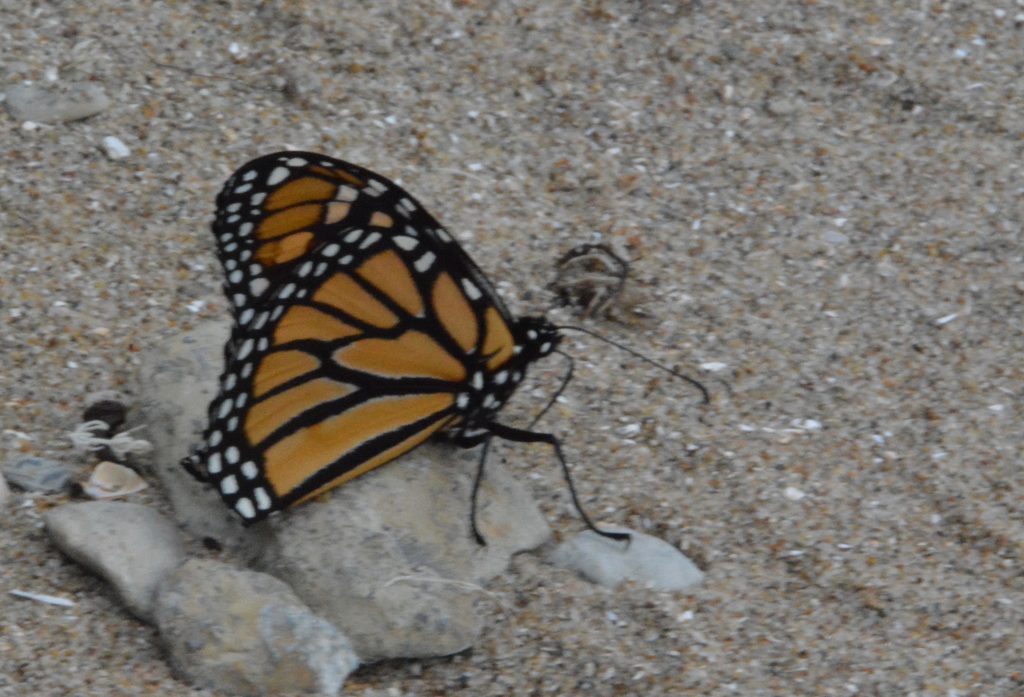
A Monarch prepares to take flight across Lake Michigan from Peninsula Point. Photo by Dale Nemeth
For decades Bob has waxed nostalgic about growing up in northern Michigan. Becoming acquainted with his boyhood home and escaping the South Texas’ summer heat were reasons enough to make the trip. But seeing this amazing part of the world and its unique geology and ecosystems turned the adventure into an awakening. What a beautiful place. Our visit also coincided with the beginning of the Monarch butterfly migration in that part of the world. Monarchs are just starting to take flight from southern Canada, thus we encountered some of our Danaus plexippus friends along the way.
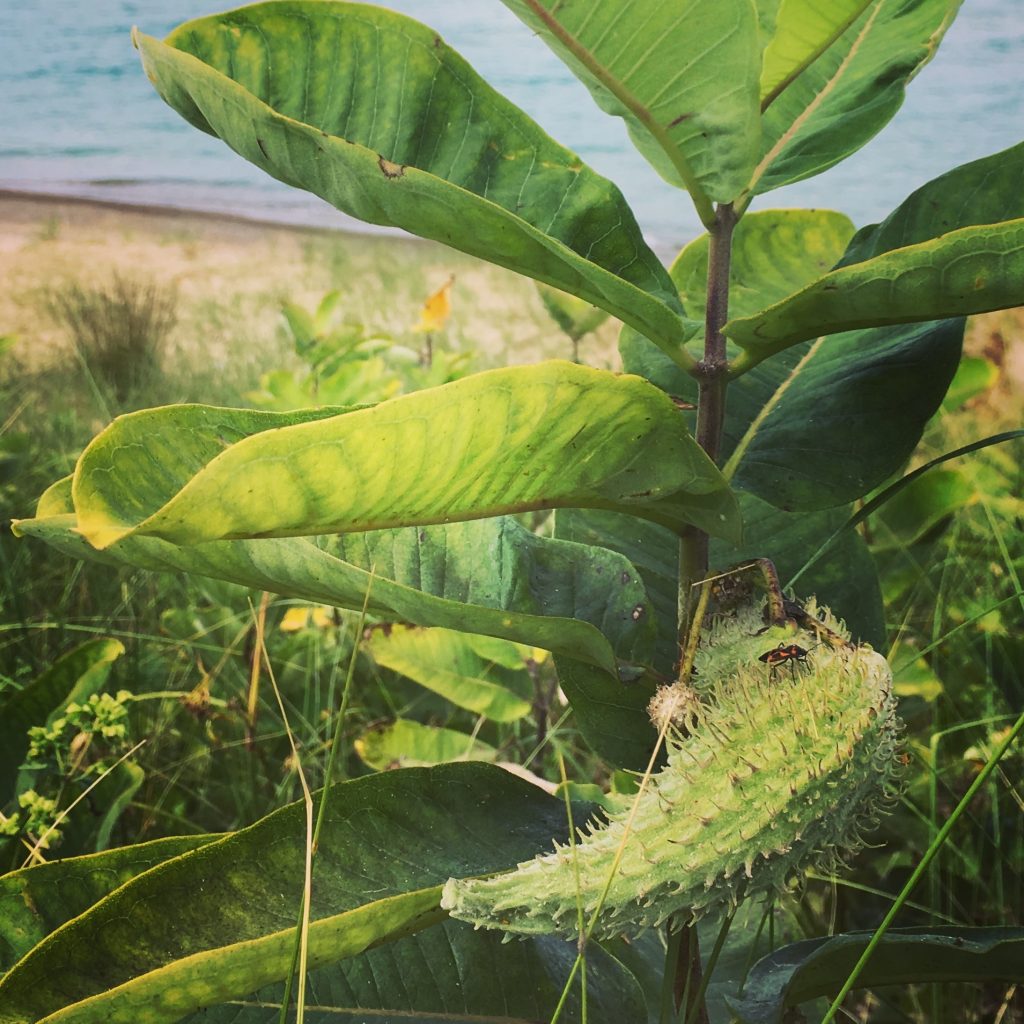
My my Michigan milkweed, what big seedpods you have! Sleeping Bear Dunes National Park –Photo by Monika Maeckle
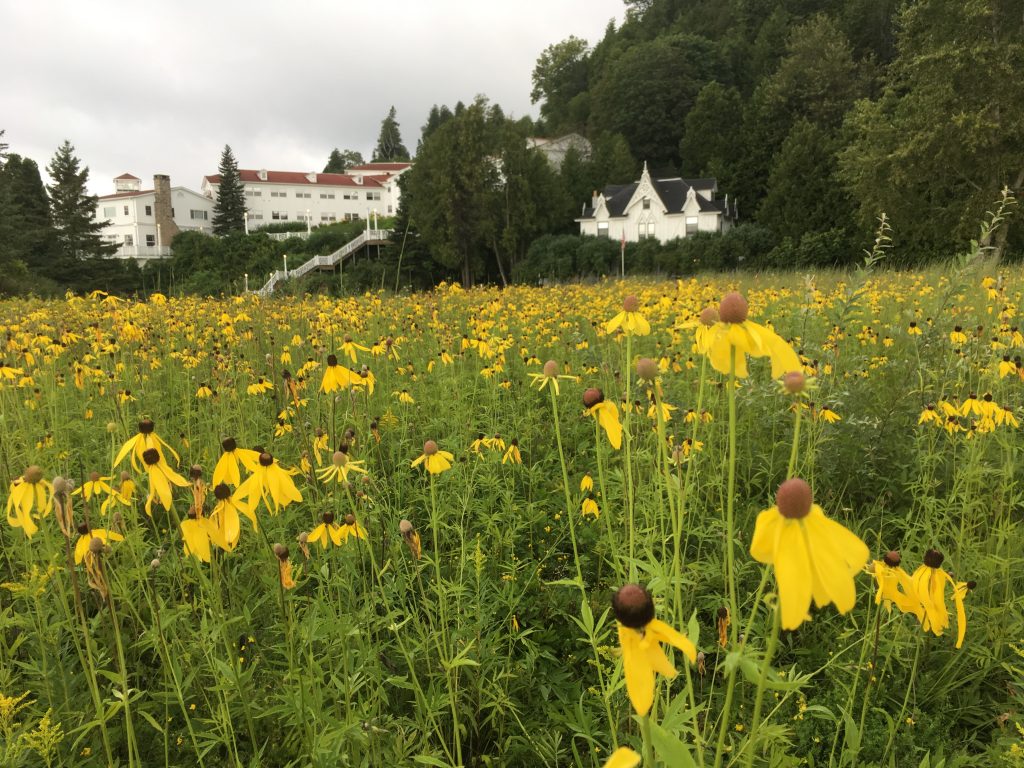
At Mackinac Island’s Mission Point Resort, Blackeyed Susans fill a beachfront prairie. Photo by Monika Maeckle
Most surprising: milkweed appears to be growing EVERYWHERE along the roadside in Michigan. True, we hugged the Great Lakes on our driving tour, but it seems that everywhere we turned–on highways, sunny clearances in forests, even at historic Mackinac Island Fort, milkweed flourished. Whether this was intentional or accidental, it doesn’t matter. Plenty of host plant exists for super generation Monarchs passing through the Wolverine State and bode well for a healthy southbound population. Dr. Chip Taylor, founder of Monarch Watch, predicted in a recent blog post that Monarchs will experience a healthy rebound this year. Prospects call for “an increase from the 2.91 hectares of last year to 4 hectares or better this coming winter or better” in the amount of space the Monarchs occupy in their winter roosting sites. Scientists calculate the Monarch population by counting the number of hectares they occupy in their roosting sites each winter in Michoacán, Mexico. The imperfect formula is currently 50 million butterflies per hectare.
Nectar plants were also abundant. Black-eyed Susan, (Rudbeckia hirta,) Smooth Aster (Aster laevis), Boneset or Thoroughwort (Eupatorium perfoliatum) and other flowers filled the roadsides and pocket prairies. Houghton’s Goldenrod (Solidago Houghtonii), a different species from the Solidago altissima that grows in Texas in late summer, can only be found in Michigan’s Upper Peninsula, or “U.P.,” as Michiganders call it. The dramatic plant, which sometimes includes strange galls that host a local moth, occupies the sandy shores of Lake Michigan, its stout yellow blooms braving the constant wind.
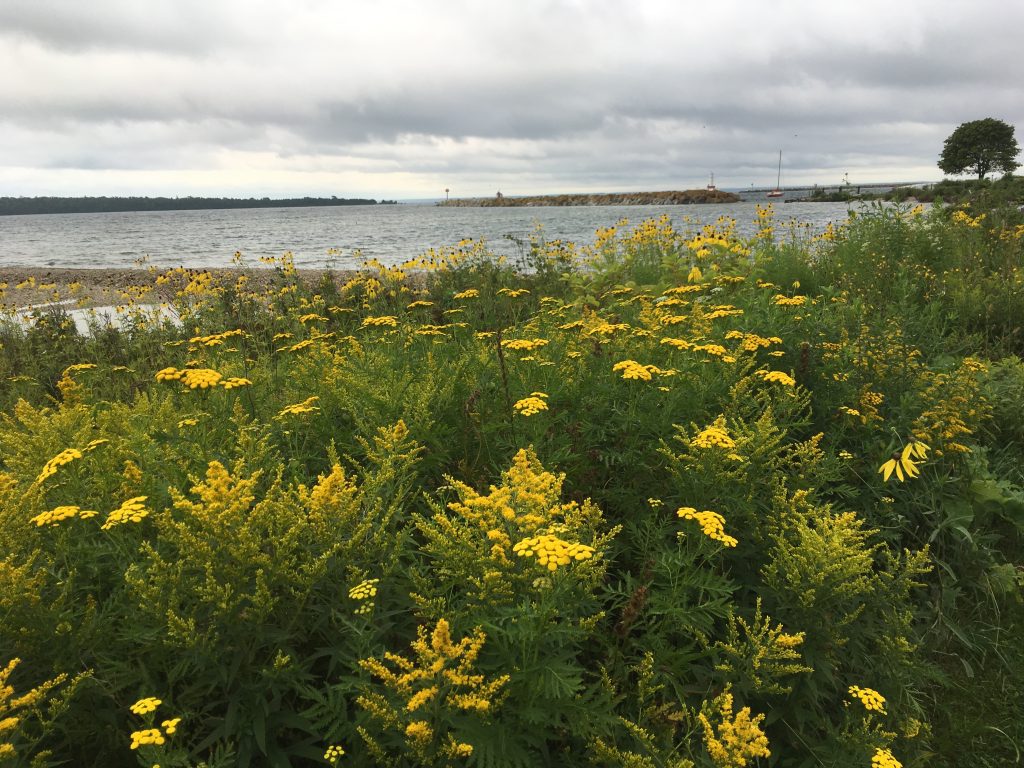
Houghton’s Goldenrod, a specialty of Michigan’s Upper Peninsula, grows prolifically along the windy shores of Lake Michigan. Photo by Monika Maeckle
A highlight of the trip was Peninsula Point, a famous Monarch butterfly staging area. The migrating insects gather on the milkweed-studded shore of this skinny stretch of sand, which juts out into Lake Michigan. A historic lighthouse marks the Point, and just as ships sailing the lake use it for orientation, Monarch butterflies utilize the strategic location to navigate their migration.
According to a plaque on the Peninsula Point Lighthouse, the area serves as one of few places in the country where one can witness Monarchs migrating en masse. The southbound butterflies gather here and use the area as a “nursery.” Just like our migrating Monarchs sometimes take a break along the Llano River or other Hill Country river bottom to wait out an unfavorable wind, these pragmatic Monarchs have patience for an optimal wind current they can jump to cross the lake.
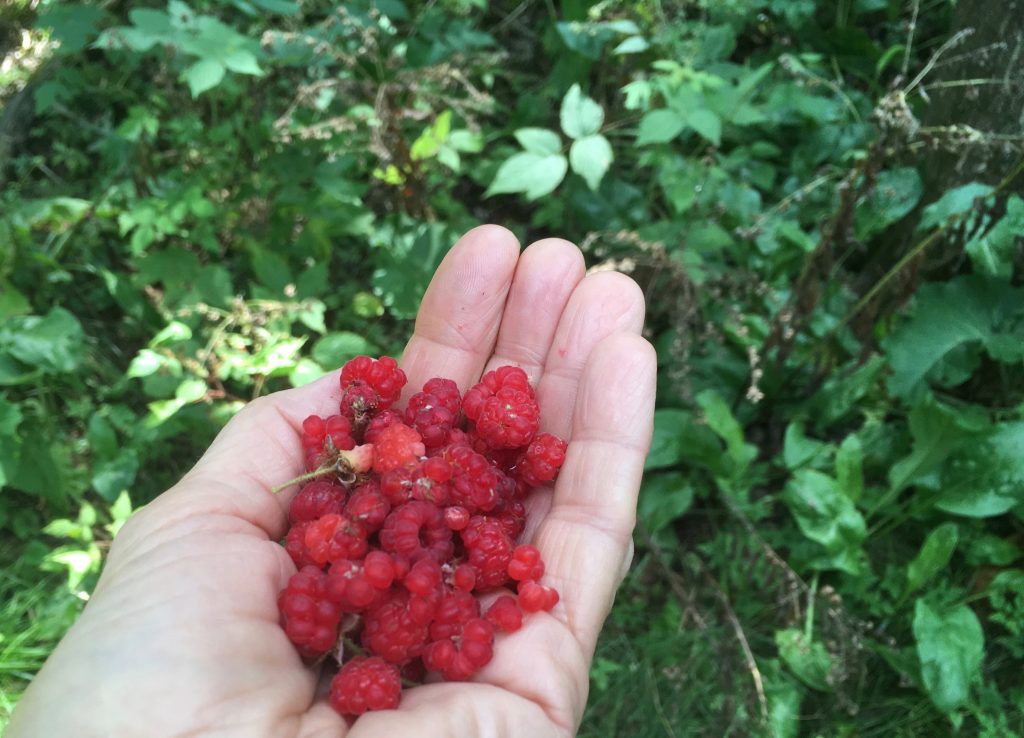
Raspberry brambles populated the forest at Peninsula POint. Photo by Monika Maeckle
Bob and I parked about a mile from the Point and chose to take a hike through the woods to reach our destination. We didn’t see many Monarchs until we came to the water, but in the forest where the sun peaked through the tree canopy, hundreds of wild raspberry brambles distracted us from our Monarch butterfly search.
Upon arriving at the Peninsula Point shoreline, we ran into Dale Nemeth, a Michigander from Stonington, not far up the road. He and his family rent a cabin every year across the water at Garden Peninsula. Nemeth sported a fancy camera with a long lens, and agreed
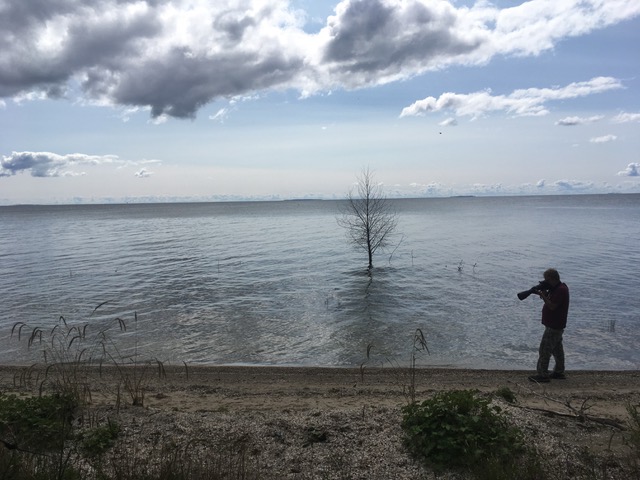
Dale Nemeth photographs Monarch butterflies getting ready to head south at Peninsula Point. Photo by Monika Maeckle
to share the picture at the top of this post. He says many Monarchs frequent the Garden Peninsula as well. “Their chrysalis amazes me…They remind me of a green pill capsule with gold engraving!” he wrote via email.
Janet Ekstrum, wildlife biologist for Rapid River/Manistique District of the Hiawatha National Forest, says the University of Minnesota operates a Monarch Larvae Monitoring Project (MLMP ) at Peninsula Point. Barring a projected frost next week which could cut monitoring short, she says MLMP will continue monitoring into mid September this year since they’re still finding eggs and caterpillars.
Related posts:
- Butterflies without Borders: Monarch Butterfly and Pollinator Festival set for October
- Migrating Monarchs take a break along Llano River, wait out winds
- Climate Change and the Monarch Butterfly Migration Symposium tackles tough questions
- San Antonio’s first Monarch Butterfly and Pollinator Festival a roaring success
- Border wall at National Butterfly Center violates property rights and worse
- Climate Change and the Monarch Butterfly Migration Symposium tackles tough questions
- McAllen becomes second NWF Monarch Butterfly Champion City
- South Texas a great base for sojourn of bees, butterflies and birds
- Monarch Champion status not “just talk,” will change how San Antonio manages land
- Guidance on milkweed management confuses butterfly gardeners
- Endangered Species Act: wrong tool for monarch butterfly conservation?
- How to raise Monarch butterflies at home, Part 1
Like what you’re reading? Don’t miss a single post from the Texas Butterfly Ranch. Sign up for email delivery, like us on Facebook, or follow us on Twitter, @monikam.

Excellent news, I follow your updates from New Zealand & we are just heading into Spring.
I’ve already noticed Monarchs around, which I think is relatively early – so that’s a good sign.
I’m on the eastern coast of the south island & we generally get pretty good summers.
I’m busy planting swan plant seeds & sourcing seedlings.
We’ve already planted a lot of nectar sources, so we should be in for a good season here hopefully.
Near where I live is a large green space (we had a devastating earthquake a few years back), the area used to be full of houses but because of it’s proximity to the river that runs through Christchurch, it’s going to stay green space & not be rebuilt. It is potentially a great source of feed for the Monarchs, another positive 🙂
Keep up the good work!
Yes , being raised in Iowa on the Mississippi River , it’s a beautiful time of year to be in the Midwest Monika. I left Texas in May of last year and travelled the summer breeding grounds until September. Native milkweed on the landscape has recovered from the catostrophic drought we experienced in 85% of the country from 2011-13 and consequently so has all wildlife including monarchs just like they recovered to almost a billion monarch in 1995-96 after the late eighties and early 90’s drought. Most Native milkweed was designed with a taproot that extends sometimes 20 ft deep into the ground enabling it to survive the severest and longest drought until precipitation returns and it comes out of dormancy putting on new stems and leaves that continue to multiply each season until the next major drought. This cycle continues as it has for thousands of years. Once monarchs have been counted overwintering in Mexico for 50 or 100 years there will be enough history to better draw the parallels between precipitation and the population. This is only common sense though. Almost all life depends on water to live. The best way we can help is plant milkweed and nectar plants in our yards and places where a supplemental water source is available to help the pollinators survive during drought on the landscape.
Here’ s the drought link. https://www.google.com/maps/d/u/0/edit?hl=en-US&mid=1pog1Dkr-1Ie6Pz_hQKud49h1i3s&ll=35.2110938071696%2C-96.05758665000002&z=5.
It’s like Monika said. Their ‘s plenty of milkweed left on the landscape and the monarchs have used all they are going to this year. Here’s a map with balloons with videos after the monarchs have left these areas in May of last year. I have video documentation of an abundance of milkweed and goldenrod from Des Moines to Connecticut in September last year. After monarchs caterpillars are butterflies. I will be adding them to this map eventually. https://www.google.com/maps/d/u/0/edit?hl=en-US&mid=1pog1Dkr-1Ie6Pz_hQKud49h1i3s&ll=35.2110938071696%2C-96.05758665000002&z=5
Here’s the drought https://www.google.com/search?q=2011-13+u+s+drought+wiki&rlz=1C9BKJA_enUS758US758&oq=2011-13++u+s+drought+wiki&aqs=chrome..69i57.16982j0j7&hl=en-US&sourceid=chrome-mobile&ie=UTF-8